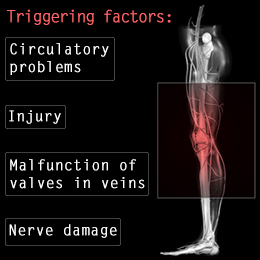Throbbing leg pain is triggered due to a variety of reasons, resulting in a lot of discomfort. This article discusses the causes of this condition, and includes some easy tips to alleviate the pain associated with it.

A throbbing sensation in the leg is characterized by an intense feeling of pain that radiates from a particular point on the entire length of the leg. Sometimes, its intensity is so severe, that standing for a short while or walking a small distance becomes quite difficult. It can be felt in just one leg, or it may affect both legs at the same time.
This pain is quite bothersome at any point during the day, but it is worse when one experiences it in the middle of the night, as it ends up disrupting a peaceful night's sleep. When this pain continues for a long time, it disturbs the normal routine of the individual and causes considerable stress.
What Triggers Throbbing Leg Pain?
A throbbing sensation in the leg is indicative of a problem in its structural components: bones, muscles, tendons, and nerves. Some common triggers of this painful condition are as follows.
Injury• Injuries caused while playing sports, or accidents can induce sudden and severe leg pain. Usually, it can be caused by a tear, a strain in the leg muscles, a fracture, or an inflammation in the tendons.
• Runners often experience stabbing pain in the shins. This problem arises as the shinbone gets injured by the excessive force exerted upon it repeatedly during strenuous physical activity.
• Sometimes, an old injury can occasionally cause pain if the area gets exerted.
Varicose Veins• This condition is brought on by the improper functioning of the valves in the veins.
• These valves perform the function of preventing reverse blood flow, by assisting in moving it towards the heart from the legs.
• When the valves malfunction, the blood gets accumulated in the veins of the legs. As a result, the veins widen, and one experiences severe leg pain.
Nerve Damage• A burning sensation in the leg, accompanied by occasional numbness could be a sign of nerve damage.
• Diabetes and deficiency of vitamins could have a damaging effect on the nerves.
• Prolonged chain-smoking and alcohol addiction may lead to problems in the nerves, resulting in leg pain.
Sciatica• Sciatica is characterized by a tingling or painful sensation beginning from the lower back, along the entire length of the leg.
• Sciatic nerve pain is induced by slipped disc in the lower back region, which presses onto the roots of the sciatic nerve.
• Sciatic nerve pain may not always be as intense; at times, it renders a sense of numbness to the leg.
Circulation Problems• Deep vein thrombosis is a circulatory problem which is characterized by formation of blood clots, deep inside the veins of the legs. Usually, it affects those people who are advised bed rest for a long time.
• Clogging up of the arteries due to cholesterol buildup leads to poor blood circulation in the legs, resulting in pain. This condition is also referred to as atherosclerosis.
Other Causes
- Arthritis
- Tumorous growth in the bones of the leg
- Osteomyelitis (Infection in the leg bones)
- Cellulitis
- Side effects of certain drugs
Treatment for Leg Pain
- The first step begins with the physical examination of the affected part of the leg. Medical history of the patient, physical activities of the patient, and timing of the pain are taken into account to identify the actual cause.
- Laboratory tests like blood tests, X-rays, imaging tests are conducted to confirm bone fractures, tumor growth, or infection. The treatment that follows is based on the underlying cause detected.
- Strained leg muscles and inflamed tendons would heal up if the legs are rested properly.
- Those with a fractured leg bone are advised to wear a cast, to ensure quicker healing.
- Pain and inflammation in the leg caused by arthritis and injury is brought down with the help of non-steroidal anti-inflammatory drugs.
- Antibiotics are prescribed to eliminate the infection that triggers leg pain.
- Any problem of the nervous system or circulatory system is resolved with the help of suitable medicines.
- A cancerous growth can be treated with chemotherapy or surgery.
- Leg pain caused by diabetes can be avoided by keeping the blood sugar levels in check.
Recurrence of throbbing leg pain can be prevented to some extent with a healthy lifestyle that includes healthy eating and regular workouts to improve strength and flexibility of the leg muscles. It is also advisable to abstain from alcohol and smoking. Remember to see the doctor at the earliest if you suffer from recurring leg pain.
Disclaimer:
This Buzzle article is for informative purposes only, and should not be used as a replacement for expert medical advice.


 A throbbing sensation in the leg is characterized by an intense feeling of pain that radiates from a particular point on the entire length of the leg. Sometimes, its intensity is so severe, that standing for a short while or walking a small distance becomes quite difficult. It can be felt in just one leg, or it may affect both legs at the same time.
A throbbing sensation in the leg is characterized by an intense feeling of pain that radiates from a particular point on the entire length of the leg. Sometimes, its intensity is so severe, that standing for a short while or walking a small distance becomes quite difficult. It can be felt in just one leg, or it may affect both legs at the same time.